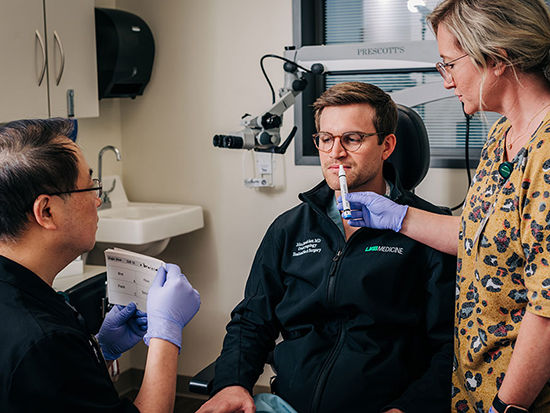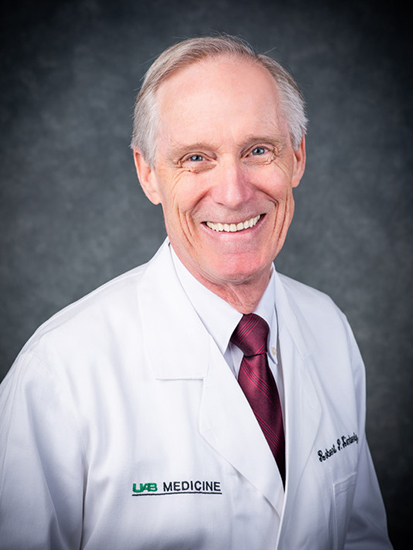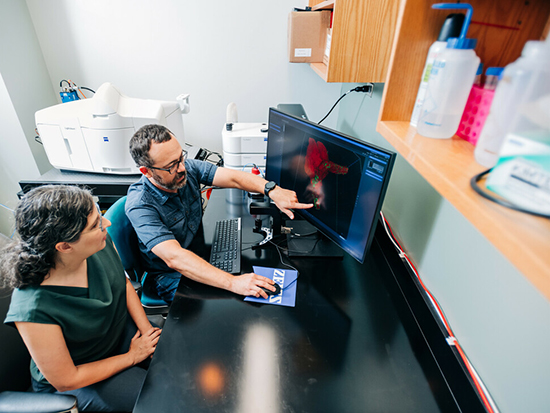 Funding from the HSF-GEF program allowed Do-Yeon Cho, M.D. (at left) to launch the UAB Comprehensive Smell and Taste Clinic in the aftermath of the COVID pandemic. “The GEF is willing to provide some support to test an idea or initiative that will enhance our clinical enterprise,” said Robert Kimberly, M.D., who leads the committees in charge of selecting projects for funding.
Funding from the HSF-GEF program allowed Do-Yeon Cho, M.D. (at left) to launch the UAB Comprehensive Smell and Taste Clinic in the aftermath of the COVID pandemic. “The GEF is willing to provide some support to test an idea or initiative that will enhance our clinical enterprise,” said Robert Kimberly, M.D., who leads the committees in charge of selecting projects for funding.
UAB is full of smart people with big ideas on how to make a great institution even better. Each year, a dozen or so get the chance to prove it with significant funding and senior-level institutional support.
Surgeon Daniel Chu, M.D., had started a pilot program in his division to prove the value of a method for improving patient recovery after major surgery. The pilot worked, but expanding it departmentwide to other specialties would require funds and the support of IT and legal. He got that opportunity thanks to a program unique to UAB that has launched projects reaching thousands of patients and kickstarted many a UAB career: the UAB Health Services Foundation General Endowment Fund, or HSF-GEF, grants program.
“It was one of my first big grants,” said Chu, who now has two concurrent R01 awards from the NIH. When he talks with a young faculty member with big ideas, Chu is sure to point them to the HSF-GEF. “I tell everyone else about this program and encourage them to apply.” (Learn more about Chu's project here.)
“Enhancing our competitiveness”
The HSF-GEF program awards grants to faculty across campus in four categories: clinical care, medical education, laboratory research and patient-oriented research. The exact amount awarded depends on the stock market — the funds are derived from investment income on a portion of the sale price of UAB’s original health management organization to United Healthcare in the mid-1990s. In the 28 years from its founding in 1996 to present, the HSF-GEF program has awarded grants totaling almost $60 million. “The GEF provides a unique opportunity among physician practices that allows us to invest in ourselves to improve our future,” said UAB President Ray Watts, M.D.
Applications window opens May 1 for 2024 HSF-GEF Awards
This site will be open May 1 through 4 p.m. June 28 for applications.
“The program has been remarkably successful and is now one of the signature programs of the UAB Health System,” said Robert Kimberly, M.D., senior associate dean for Clinical and Translational Research in the Heersink School of Medicine, who leads the committees in charge of selecting projects each year. They put out a call for applications in the spring and announce recipients in the late fall, with each committee putting forward its recommendations on the projects it would like to support. “We always have a robust selection,” said Kimberly, who estimates that one in four or one in five applications receives funding. Every application is required to have a plan for sustainability once the GEF grant funding expires.
 “The program has been remarkably successful and is now one of the signature programs of the UAB Health System,” Kimberly said.“This is an important way to enhance our competitiveness as an institution,” Kimberly said. “The program also explicitly acknowledges that our missions of research, education and clinical care, and outreach are interrelated, and provides a mechanism for the Health Services Foundation to demonstrate its commitment to these missions.”
“The program has been remarkably successful and is now one of the signature programs of the UAB Health System,” Kimberly said.“This is an important way to enhance our competitiveness as an institution,” Kimberly said. “The program also explicitly acknowledges that our missions of research, education and clinical care, and outreach are interrelated, and provides a mechanism for the Health Services Foundation to demonstrate its commitment to these missions.”
The first choice for big ideas
UAB’s Academy of Health Professions Educators began out of conversations that Caroline Harada, M.D., a professor in the Department of Medical Education, had with Lisa Willett, M.D., a professor in the Department of Medicine, “about the need for training, mentorship and recognition for our junior faculty clinician educators,” she said. The Academy received HSF-GEF funding in 2019 and 2021; since then, 10 participants have already been promoted, 20 have new educational leadership roles, and between them they have received 24 teaching awards. “HSF-GEF was the obvious place to apply for funding, because we know they appreciate innovation and interprofessional collaboration,” Harada said. “It would not have been possible to create the Academy without this type of financial support.” (Read more about Harada's project in this story.)
The HSF-GEF education grants have also supported an innovative program for staff development. Cynthia Joiner, Ph.D., an associate professor and vice chair in the Division of Cardiovascular Disease, is the department’s executive director for its Clinical Research Enterprise. She worked with Ryan Outman, executive officer for finance and administration in the Heersink School of Medicine, and other colleagues to put together a proposal that became the Developing Emerging Administrative Leaders program, or DEAL. Their goal was to train a new generation of staff leaders and expose them to the opportunities available across the UAB enterprise. (DEAL is open to any UAB employee.) For their first cohort, launched in October 2022, Joiner and Outman hoped for 25 applicants; they received 86. The second cohort, in fall 2023, had an even larger response. “We could not have done this without the HSF-GEF,” Joiner said. (Learn more about DEAL in these Reporter stories: DEAL program shows staff how to navigate their careers at UAB and New class enters UAB Developing Emerging Administrative Leaders Program.
“Why I want to work here”
“For me, these HSF-GEF awards exemplify why I want to work here,” said Carlie Stein Somerville, M.D., an associate professor in the Division of General Internal Medicine. Somerville collaborated with Betsy Hopson, then program director for the UAB and Children’s of Alabama Spina Bifida Program, to launch the UAB Staging Transition for Every Patient, or STEP, Program with HSF-GEF support. The multidisciplinary STEP clinics now see hundreds of patients per year, and Somerville has presented on the program at national conferences. The HSF-GEF grants are “a huge recruitment tool for us,” with residents and with faculty, Somerville said. “It is a viable option for junior faculty at UAB to build something amazing. The financial piece is important. So is the fact that you can find people at UAB to support you and collaborate with you when you want to create new medical initiatives. If you can tell your patient story and express the barriers that patients face, people here want to help you do something about it.” (Read more about Somerville and the STEP Program here.)
The HSF-GEF grants framework is critical, adds Hopson. She received a second award in 2023 with Snehal Khatri, M.D., associate professor in the Division of Developmental and Behavioral Pediatrics. Hopson and Khatri are launching a new lifespan care program for patients with Down syndrome that is modeled in part on the success of the STEP Program. “Getting one of these grants gives you the credibility to say, ‘The institution believes in what we are doing,’” Hopson said. “It brings everybody to the table. I have felt a tremendous amount of support from the committee.” (Read more about Hopson and Khatri's Down syndrome clinic here.)
“Many external funding mechanisms available to investigators are so specialized to a disease or topic that good projects can’t get off the ground,” said Michael Mugavero, M.D., professor in the Division of Infectious Diseases. That is the case for the UAB Learning Health System Platform, an initiative led by Mugavero that was funded in 2021. “The HSF-GEF grants are crucial in terms of supporting projects that might otherwise not have a chance to see the light of day.” (Read more about the UAB Learning Health System Platform here.)
 “The strategy is to demonstrate to extramural sponsors that the institution has skin in the game,” Kimberly said. Above, Alexa Mattheyses, Ph.D., director of the UAB High-Resolution Imaging Facility, and Robert Grabski, Ph.D., in the facility. Mattheyses has received two HSF-GEF grants to enhance its capabilities for UAB researchers. “The strategy is to demonstrate to extramural sponsors that the institution has skin in the game,” Kimberly said. “We are willing to invest in these projects ourselves.”
“The strategy is to demonstrate to extramural sponsors that the institution has skin in the game,” Kimberly said. Above, Alexa Mattheyses, Ph.D., director of the UAB High-Resolution Imaging Facility, and Robert Grabski, Ph.D., in the facility. Mattheyses has received two HSF-GEF grants to enhance its capabilities for UAB researchers. “The strategy is to demonstrate to extramural sponsors that the institution has skin in the game,” Kimberly said. “We are willing to invest in these projects ourselves.”
“It allows you to fill in gaps of need and really help drive technology forward both at the preclinical research level and in clinical research,” said Anna Sorace, Ph.D., who has received two HSF-GEF awards in the Laboratory Research category in her capacity as director of the UAB Small Animal Imaging Facility. Each project has expanded the core facility’s capabilities by allowing the purchase of new equipment to support UAB’s growing nuclear imaging program. This, in turn, increases the chances of success in applying for large-scale programmatic grants from the NIH and other funders. “We would not have been able to do this without HSF-GEF support, and because we are embedded into a core facility, we are available for any investigator to use,” Sorace said. (Read more about Sorace's projects here.)
Innovating at the edges
“The GEF is willing to provide some support to test an idea or initiative that will enhance our clinical enterprise,” Kimberly said. “We all know that not everything is going to work. But if we don’t try, don’t innovate at the edges, we are going to run the risk of stagnating.” Although the HSF’s investment income has provided the program with ongoing support for more than 25 years, there are always more good ideas than funds to support them, Kimberly points out. “This is a very competitive program,” he said. “If other organizations or businesses would like to join in, we have many areas where our interests are and should be aligned. I would love to see that happen.”
“This is a place where, if you have a good idea, you can find the support to make it a reality,” Mugavero said. “That helps with recruitment of new faculty.”
“When faculty come to visit and you already have these systems in place, that is such a benefit in recruitment,” Sorace agreed. “It is a lot easier to come to a university where they have everything in place.”
Support from HSF-GEF also is critical to retaining faculty as well, Mugavero added. “Researchers are often working in niche spaces, and they can find it hard to connect with ‘their people.’ Thanks to the HSF-GEF grants, we can build programs and say, ‘Here are your people.’”
How do the HSF-GEF awards advance UAB? Faculty explain their projects:
How the HSF’s General Endowment Fund awards help UAB compete on a national stage
Advancing faculty careers through the UAB Academy of Health Professions Educators
Building immuno-imaging at UAB through specialized technology
Turning a pilot project into the standard of care
Making the leap from one hospital to another through UAB’s STEP Program
Building a health system that can learn calls for “team science to the max”
Using geographic information systems in patient-oriented research